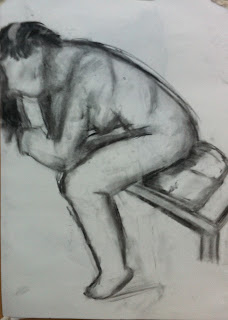Tuesday, 29 November 2011
Monday, 28 November 2011
Character designs on paper
Here are my rough sketches and ideas for my two character for my carers project. They are two Teddy bears, one being the younger sibling, who is cute and scruffy. The older one is cleaner, but strict.
Fur in Maya
I have added fur to the bears to give them a much more realistic look. This was achieved in Maya - and as you can see both bears have different fur attributes to separate their look and feel. The bigger bear is a clean new bear, and the smaller bear is very old and quite fragile.
Sunday, 27 November 2011
Working in Maya, and creating my first project.
In the last couple of weeks, I have picked up Autodesk Maya again, and taught myself the foundations of 3D animation, and have started to work on my own project. So far, I am pleased with it, and perhaps somehow I could incorporate it in to my carers project.
Friday, 11 November 2011
Changing my character design dramatically
I have thought about my character design, and whilst experimenting at home, I have recently developed two character designs in Maya which I would prefer to use. This therefore changes my outlook on the project from a surreal manner to a cute and colourful CGI look.
Tuesday, 8 November 2011
Carer project - Character design concept.
Introduction to negative space
In our life drawing class today, not only were we introduced to a new skill, I managed to overcome my fear of trying a new style. It's all too easy sometimes to stick within your comfort zone, but I learnt a lot, and I'm glad I just went for it. Photo to be uploaded soon!
Human life drawing
Here are my two final life drawings from our life drawing classes. I used a different range of materials to achieve both looks. The one on the left was drawn with pencils, whilst the one on the right was drawn with charcoal
Wednesday, 2 November 2011
Questions and Research.
I have taken an interest in surreal types of animation, ranging from different methods of animations, and I want to know; what contributes to a films mise en scene, and various other questions:
- What other animators are out there producing surreal work, and could I perhaps study their work for both inspiration and theory practice?
- How do various countries receive surreal filmography? Do some cultures and nationalities perhaps find it more vulgar and offensive than others? If so, which countries should I research?
- What methods of animation are there to create these pieces? Apart from the 3 main ones: cell animation, CGI and stop motion.
- Where do these animators look for inspiration? Perhaps past events, personal thoughts, or even inspiration from other pieces of work.
- Where would they submit or contribute their work? Film festivals, online websites, show reels?
- What do animators or writers base their work on? Imaginative surrealism or perhaps satirical, political, religious etc.
These questions tie in with the research I have done about surrealism and its roots. Like most animation, it takes a lot of inspiration from past artists, and this is clearly evident in surrealism
 |
| Melting Clocks - Salvador Dali |
Surrealism actually started of as a cultural movement in the early 1920s that consisted of ‘group members’ who would create visual artworks and even writings that were often non sequitur, and give a surprise, due to the ‘at the time’ groundbreaking way of delivering arts. Despite a lot of peoples ‘snobbish’ approach to the surreal movement, their members regarded “that their work as an expression of the philosophical movement first and foremost”
The movement essentially started in Paris, however from the 1920s onwards, surrealism caught on with many more countries and eventually spread worldwide, and since then has had a huge impact on many different platforms of the arts including: filmography, music, visual arts and even the way people look at politics and social theory.
Subscribe to:
Comments (Atom)











